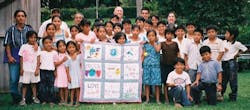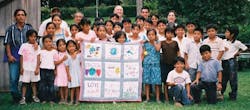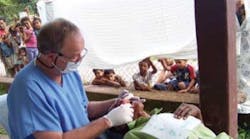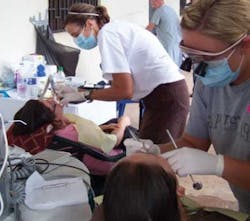Central America missions
Dental hygienists participate in charity trips in Honduras and Guatemala
by Susan B. Solomon, RDH, MA
Those of us who have participated in dental missions agree that we are the lucky ones, that we have been vastly enriched by our experiences. I was fortunate to join four dental missions to Central America from 2003 to 2009 – two to Guatemala and two to Honduras. I love the Spanish language and the character of the people who speak it, and I welcomed the chance to go to Central America. I learned a lot about the people I treated and the countries I visited, and I was inspired to think about how the conditions there could be improved.
I wanted to participate in a dental mission to Guatemala ever since I lived on The Farm (www.thefarmcommunity), a large intentional community in Summertown, Tenn., whose goal is to have a positive effect on the world. The Farm founded its own international relief organization, Plenty International (www.plenty.org), which sponsored a group of carpenters, medical personnel, and soy technicians to help the Guatemalan Mayan highland population reconstruct their villages after a devastating earthquake in 1976. Many indigenous Guatemalans became our friends, especially when the political regime became deadly for them and they came to live on The Farm. I was lucky to become friends with a number of Guatemalans who lived in my neighborhood and who I worked with in our dental clinic.
Years later, after raising my family, the opportunity to go to Guatemala presented itself while I was working as a dental hygienist in the Nashville area. A group of Rotarians let me accompany them on their annual dental mission to treat children there. I went with this group, headed by pedodontist Bill Taylor, in 2003 and 2004.
A "More Than Warmth" friendship quilt is presented to a school in the Retalhuleu region of Guatemala.
A dentist and church missionary in Guatemala City, Mike Kadera, who practiced dentistry as well as worked with orphans and AIDS patients, was part of Dr. Taylor's group each year. Dr. Kadera and the Guatemala City Rotarians arranged an outreach dentistry project in the countryside, and together with the Tennessee team and some local dentists, saw as many children as possible.
The 2003 mission involved going to western Guatemala, hours away from Guatemala City. We set up our first series of makeshift clinics for the schoolchildren in the southern slope region of Retalhuleu, which has many plantations. We saw children with horrendous teeth, since they are raised with sugary drinks, no dental care, and often do not even own a toothbrush. The makeshift clinic setup did not include the compressors and mobile units needed to do fillings. So unfortunately the most good we could do was pull the teeth that were the source of the greatest infection and discomfort for these children.
Since I can speak some Spanish, I was able to establish rapport with the children. I examined and anesthetized the area of extraction for the dentists. Two of the days we set up in schools, one day in a municipal building on an indoor basketball court, and one day on a plantation. With advance planning, we treated the many schoolchildren brought to us.
Village children gather to catch the best show in town – Dr. Jim Bevans treating a patient on the Duyure Centro Social patio.
The 2004 mission was centered closer to Guatemala City in the highlands, where we were given part of a hospital and also an orphanage schoolhouse to use. My friends at Plenty provided us with several More than Warmth friendship quilts as gifts to each school that brought its children to us. (www.morethanwarmth.com) (See photo)
My next opportunity to join a dental mission came in 2008 when local periodontist Jim Bevans, DDS, of Hendersonville invited me to join him on his extraction clinic as part of Christopher Ministries' medical mission. Dr. Bevans had worked with this group on its well-organized missions for many years and welcomed the help. As I had done before, I solicited toothbrushes, toothpaste, floss, anesthetic, gauze, and more from suppliers, which filled many suitcases.
In addition, I decided to keep track of what we did by constructing a small dental form. I learned from my first mission that I needed a chart to communicate my examination findings, let the dentist know which areas I had anesthetized, and keep a tally of our work. Dr. Atul Gawande's book, Better, suggests that we count something. So I did! In four days as a team, with one interpreter and a sterilization assistant, 350 teeth were extracted.
Our clinic in Honduras was at the Duyure Social Center, to which people would often walk for hours for an opportunity to see a doctor, dentist, or get eyeglasses. I returned to the same location the next year despite the fact that a military coup had removed the duly elected president, Manuel Zelaya, one month prior to the mission. We were uncertain if we would even go that year, and despite the fact that several team members understandably cancelled their trip, many of us persevered. The coup atmosphere added a level of tension to this trip; our clinic hours were limited by a curfew, so we had to depart from Duyure for the hour-long bus ride back to Mission Lazarus in a timely manner.
The dental sealant team of Christopher Ministries is hard at work in Duyure.
The Guatemalans and Hondurans do not receive adequate dental care because they are poor, have large families, and live in agricultural societies where cost and distance are insurmountable. There is a great need for more education and prevention of dental disease. After three years of working with extraction missions, I decided to bring some pit and fissure sealants and fluoride to try to prevent future extractions. My friend Holly Hill, RDH, agreed to help. Dr. Bevans provided her with a mobile unit and compressor to dry and suction. The hygienist team on this mission sealed 270 teeth; this was our "crowning" glory! We also did minor fillings and some prophylaxes with the help of a mobile cavitron.
These missions require advance planning. One member of the Honduras team was Meredith Jones, RN, from Mission Lazarus. She had reserved the building and given out appointment "tickets" to those in need from the villages. Meredith and I communicated via e-mail for months prior to the mission about the dental clinic's need for an expanded preventive area.
The dentists in Guatemala and Honduras are trained as preventive specialists, and also learn restorative dentistry, oral surgery, and endodontics. There is a great need for public health dental hygienists, and this would be a good beginning for a profession of dental hygienists in third-world countries.
In the meantime, attending a dental mission is a wonderful and enriching experience for anyone lucky enough to go!
Susan B.Solomon, RDH, MA, has a bachelor's degree from Douglass College, a master's in history from Yale University, and an associate's degree in dental hygiene from Meharry Medical College/TSU. She practices dental hygiene in Goodlettsville, Tenn., and she is a member of ADHA, has held various offices with Nashville Area Dental Hygienists' Society and is a long standing member of the Tennessee Academy of Dental Hygiene. She can be reached at [email protected].
Past RDH Issues



